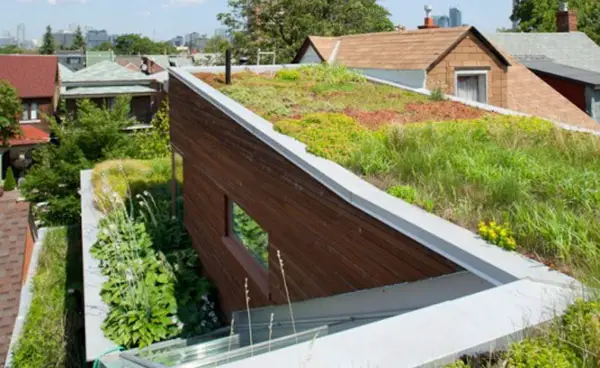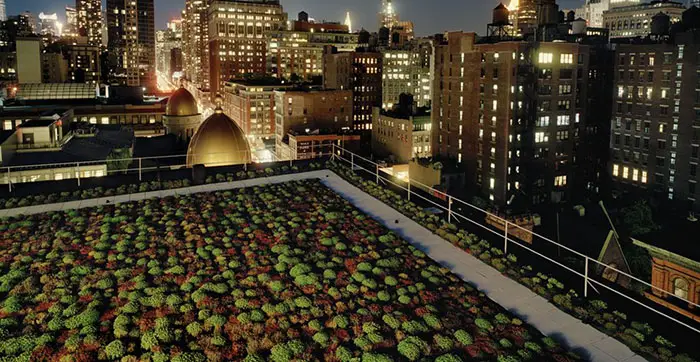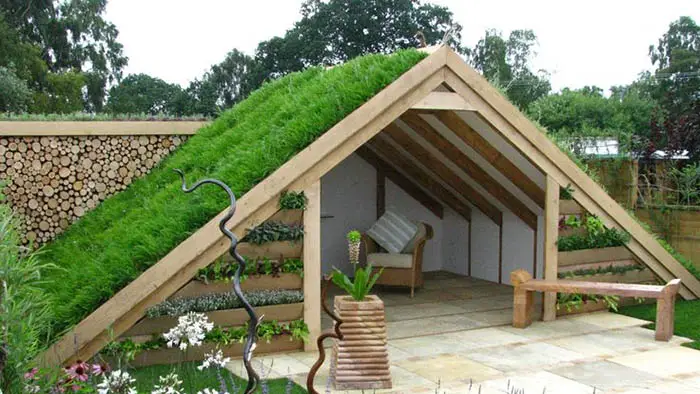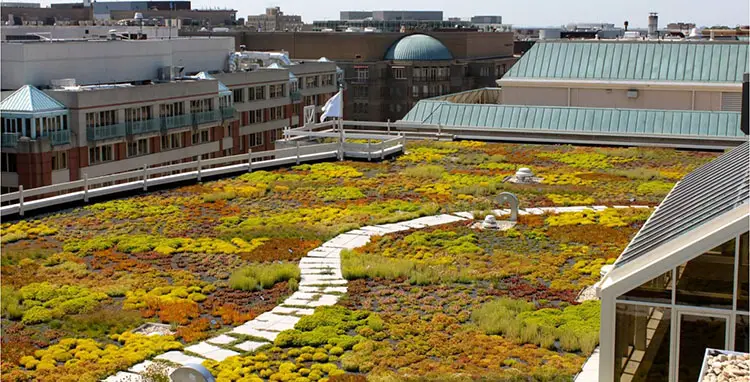The extensive green roofing, or EGR, movement is taking hold quite strongly on a global level. The idea of green roofs is rooted in a quite ancient methodology; the concept is not exactly new.
Contents
Scandinavian and Icelandic natives have used sod as the base insulating material for roofs for centuries. Even Tanzania has a history of mud huts topped with grass rafters to provide a cooler ambiance for homes in the rough environment.
However, modern eco building roofs are technologically advanced in terms of the planning of the green roof layers. The basic constitution of an EGR is as follows.
They have a waterproof membrane to protect against water seepage problems for the interior. Then there is a root barrier and a layer laid specifically for drainage. At the top is the ‘green’ layer consisting of cacti, shrubs, and sedums.
WHAT ARE EXTENSIVE GREEN ROOFS?

The living building tops, or EGR systems, are new-age summits with a vegetated substrate extending to the surface. The vegetation for EGR mainly comprises sedum moss, shrubs, and herbaceous plants; the choice depends on the estimated weight of the EGR.
While the modernization of eco roofing technology has taken place quite recently, significant developments have already been made in the field.
Today, clients can request customization in designs for a number of different varieties of green roof plants for their summits. The designs can also be extended to any kind of impervious surface on your house.
The creation of these summits, however, requires a professional level of horticultural experience as well as a sense of architectural design (specifically, roofing).
You should also realize that, at the core, the green summit is an extended garden surface and will require a modicum of patience until you can see true décor efficacy.
HOW IS EGR THE FACE OF URBAN ECOSYSTEMS?
The main problems with modern-day urban areas are that the increasing number of buildings in these areas completely alters the natural flow of matter and the energy through the surrounding ecosystem.
However, with eco summits, these energy problems can be gradually eliminated with a consistent change in the surface of the built areas of the buildings.
After all, these areas constitute the major players in the changing flux of energy and water relations of the building. Here is a rundown of the ways in which eco summits are redefining urban ecosystems:
- When you add vegetation and soil to your summits, you are actively employing a technique to reduce the negative effects of your building on the surrounding ecosystem. You will also reduce your building’s overall energy consumption.
- An extensive green roof boosts the effects of your building’s sound insulation.
- The living roofing technique has been tested to reduce the chances of fire hazards by increasing the fire resistance of the building.
- Your EGR can facilitate the increased longevity of your rafter’s membrane.
- EGR has shown a high potential for reducing the ambient temperature of a building’s interior. This is because the growing plants intercept the solar radiation and then dissipate that energy to reduce the heating effect on the interior environment.
- EGR tops have been known to reduce runoff caused by storm water. Usually, the plants on the surface of the summit collect the precipitation during a storm. This reduces the volume of the water flowing into the storm water drainage infrastructure and the waterways around the urban ecosystem.
- Apart from the above-mentioned benefits, living summits show a high potential for improving the quality of the air around the area, thereby reducing the heat-island effect, which is common in most urban areas. They have also been known to be used as a natural habitat for surrounding wildlife and an overall green-space feature for the urban ecological unit.
DISTINGUISHING FEATURES OF AN EGR

Depending on certain distinguishing characteristics of your eco roofing system, you can choose between two types of eco summits – Extensive and Intensive.
Both the EGR and intensive summits can be easily constructed for sloped and solar roof structures. However, the EGR is the most popular eco-summit option for most types of buildings.
Extensive eco-roof – its type of vegetation mainly characterizes this kind of summit. This primarily comprises sedums, small grasses, or small herbaceous plants.
- These varieties require little to no maintenance, and there is no need to install a heavy-duty permanent irrigator to maintain the vegetation.
- The soil depth of this type of living rafters is calculated at 3-6 inches at an average.
- This variety of extensive green roof is most ideal for areas which need year-round storm water management.
- This green roof system is highly cost efficient, particularly in the long run, due to almost no need to maintain a high-end maintenance system.
- They are usually lightweight, ranging from 15-50 pounds per square foot.
- They require only an average of 10-20% organic and nutrient matter in the soil to maintain their particular type of vegetation.
Intensive green variety rooftops can be further divided into a subcategory of semi-intensive rooftops depending on the type of plants and the soil depth required for constructing the structure of the intensive eco-roof.
SPECIFIC VEGETATION FOR EGR
EGR structures are a challenging environmental condition with respect to the proper design and maintenance of a green landscape.
It is important to choose the perfect variety of living rooftop plants to handle the strict conditions of elevated temperatures and extreme weather.
The plants that are ideal for living rooftops are usually varieties that can handle the pressure of growth under extreme weather conditions.
That is why the most common choice of plants in this case includes green moss, sedum, cacti, and ornamental grasses. However, the soil depth and organic matter content will also determine the types of vegetation that will survive on green eco-rooftops.

Sedum-moss growth – this is ideal for rooftop soil substrate that ranges from 2-5 cm in depth. This allows the sedum to thrive because the soil is more desiccation-prone.
This range of soil also supports the growth of succulents that have highly evolved characteristics, such as water retention and defenses against high wind and harsh sunlight.
Native plants and perennials (Miniature) – for areas that have a high volume of rainfall, often native varieties of plants and perennials are preferred for green summit vegetation.
These plants are usually more adaptive to local weather conditions and can thrive on rooftops with the correct management of irrigation and a mineral-based substrate. Often this vegetation is part of the intensive summit.
However, bonsai or miniature perennials can be included for both the intensive and EGR varieties of summits. Perennials require much more attention than regular herbaceous vegetation.
They also need to be complemented with the correct variety of vegetation because they create shaded areas that might not support certain plant species.

Stress – tolerant forms of vegetation: exotic vegetation forms, specifically the high-stress-tolerant variety, are highly in demand for living rooftop designs.
These plants can be imported to a different environmental condition and experimentally combined in landscape design ideas for tricky rooftop conditions. These plant species also help in the evolution of biodiversity in the region and create a distinctive eco-community.
The scope of plants that can be used for living rooftop designs is increasing every year as the concept becomes worldwide. Many regions are taking ideas and plant species samples from a wide variety of regions that maintain similar climactic conditions.
The idea is to create living rooftop gardens that are pleasing to the eye, are able to survive extreme weather conditions, and require the minimum amount of maintenance. You can also decide, for semi-EGR designs, to begin your building top transformation.
IS YOUR BUILDING A GOOD CANDIDATE FOR AN EXTENSIVE GREEN ROOF?
While an extensive green roof is a very advantageous and decorative trend at the moment, not every building is equipped to handle this kind of roofing structure.
It is important to get your building evaluated for a detailed check as to whether an EGR is a good fit. The following are some of the characteristics of buildings that are suitable for an eco-roof.
- Your building top needs to be flat or sloped only up to 30 degrees to support the growth of a living summit.
- For a green roof, your building top needs to be in a very sunny location and should not have any huge trees providing too much shade on the growth area for the eco vegetation.
- EGR weighs a lot more than conventional rooftops, so you will need to get your building evaluated to determine if it can adjust to the additional weight of the rooftop soil after a good bout of rain in the area. It can get as heavy as an added 20 pounds per square foot. You can also choose a semi-area EGR instead of full coverage
- The cost for EGR can range from 12-35 dollars per square foot. You will also need to include the cost of hiring a professional roofer with experience in horticulture and previous EGR installations.
- Most homeowners have a dual perspective as to whether they need a Zamp Solar 115-Watt Expansion Kit, Add More Power to any Roof Top Solar System for energy conservation or an eco-roof for a healthy eco-culture. While the weight and design make this not a possibility for all home structures, you might be able to choose both if your home has flat as well as sloped sections of building top. You can use your building summit to create a semi-layer design. You can use the flat area for the vegetation of the eco-summit, while the sloped section can hold the weight of the solar panels.
Last update on 2023-07-04 / Affiliate links / Images from Amazon Product Advertising API
Hi, I’m Jim. I was a roofing constructor for 20 years, before deciding to start myrooff.com and gather the best content about roofing. I love woodworking and construction and it was only natural for me to start this passion project of mine. Thank you for visitng.

